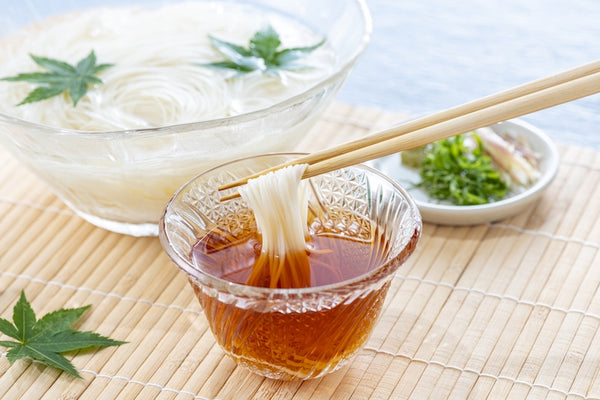The Ultimate Guide to Japanese Noodles

Noodles have a rich history in Japan and are integral to Japanese cuisine. They're extremely versatile and can be enjoyed in soups, stir-fries, dipped in sauces or in salads. Some of them may seem similar but there are countless varieties based on the ingredients and regional flavors. There's a noodle for every taste!
Ramen (ラーメン)
Ramen is one of Japan's most popular noodle dishes. Meaning "pulled noodles", ramen consists of Chinese wheat noodles served in a meat or (occasionally) fish-based broth, often flavored with soy sauce or miso, and uses toppings such as sliced pork, nori (dried seaweed), egg and scallions. The noodles are thought to be imported from China and are sometimes also called chuka soba, meaning “Chinese soba.”

Ramen comes in many different varieties, adjustable to one’s taste, including:
Shio ramen: Lighter in color, shio ramen comes in a yellowish salt broth. The flavor is lighter as well and generally includes straighter noodles rather than curly ones.
Miso ramen is also popular and there many different regional specialties.
Soba (そば or 蕎麦)
Meaning buckwheat, soba refers to noodles that are usually made with a mixture of buckwheat and wheat flour. In Japan, soba noodles can be found in a variety of settings, from "fast food" places to expensive specialty restaurants. Interestingly the popular dish "yakisoba", fried noodles cooked with pork, vegetables and egg, is in fact made using Chinese noodles and not actually made with soba! Along with udon, soba is the most consumed type of noodle in Japan. Zaru-soba is chilled and served on a bamboo tray with little bits of nori seaweed and green onions, then dipped in a tsuyu sauce. Traditionally, soba eaten on New Year’s Eve in Japan called toshikoshisoba.

Udon (うどん)
Udon noodles are the thickest of the Japanese noodles. Easily recognizable, the noodles are thick, chewy and white. They're often served hot in a noodle soup. The simplest form is kake udon, or in a mildly flavored broth called kakejiru, which is made of dashi, soy sauce, and mirin. It's also usually topped with thinly chopped scallions.

Kake udon is a type of dish where freshly boiled noodles are put into a donburi bowl with hot tsuyu soup poured on top.
Bukkake is a type of cold udon where udon noodles and toppings are chilled and served with a cold tsuyu dipping sauce.
Udon is also popular for use in various nabe (hot pot) dishes.
Shirataki (しらたき)
Shirataki noodles (aka miracle noodles) are a low-carb pasta alternative. The word shirataki means white waterfall, referring to the appearance of these noodles. Made from konnyaku, shirataki noodles are about 97% water and 3% fiber, so virtually carb- and calorie-free. They can be found both wet and dry and can be used in many dishes in place of wheat-based noodles or even pasta.

Sōmen (素麺)
What's better on a hot summer day than chilled somen noodles?
Somen is a product of three simple ingredients: flour, salt and water. Flour is kneaded with salted water to make an extremely thin noodle dough. It's usually served cold with a soy and dashi dipping sauce.
You may have heard of hiyamugi, which is often confused with somen. Hiyamugi is made roughly the same way as udon, with the noodles being sliced by a knife into thin noodles. Somen noodles, on the other-hand, are made by stretching the dough until it is extremely thin.

Each region has its own version of the noodle classics, with the recipes having being adapted to reflect local tastes and specialties. What is your favorite type of noodle?
About the author:
 Hello, my name is Suzan, 20 years old student in Sofia University, Bulgaria. My major is Japan, so as can you guess I’m now studying about their rich and beautiful culture and language as well. That is why I find great pleasure doing these articles as it gives me the opportunity to expand my knowledge and it’s easy doing something you love.
Hello, my name is Suzan, 20 years old student in Sofia University, Bulgaria. My major is Japan, so as can you guess I’m now studying about their rich and beautiful culture and language as well. That is why I find great pleasure doing these articles as it gives me the opportunity to expand my knowledge and it’s easy doing something you love.




